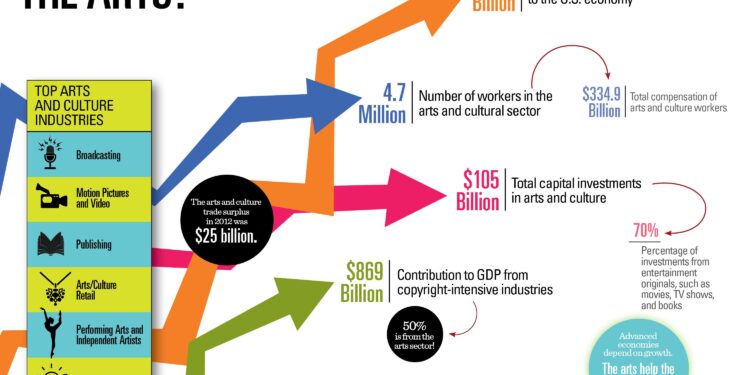The arts economy on Long Island is showing promising growth, signaling a vibrant cultural resurgence across the region. However, despite increased activity and rising contributions to the local economy, funding for arts organizations and projects continues to fall short of demand. This disparity highlights ongoing challenges for artists and institutions striving to sustain and expand their work amid limited financial support, underscoring a critical issue for stakeholders in Long Island’s creative sector.
Arts Economy Expands on Long Island Driven by Increased Audience Engagement
The Long Island arts sector is experiencing a notable surge in vitality as attendance numbers at galleries, theaters, and cultural festivals continue to climb. New data indicates that local arts organizations have seen a 20% increase in audience engagement over the past year, driven by innovative programming and a growing public appetite for diverse cultural experiences. This expansion is fostering job creation and stimulating adjacent industries, highlighting the arts as a significant economic engine in the region.
However, despite these promising trends, funding has not kept pace with the sector’s growth. Many arts groups report persistent financial challenges, including limited access to both public and private grants. Below is a snapshot comparing audience growth with funding changes among key categories over the past 12 months:
| Category | Audience Growth | Funding Change |
|---|---|---|
| Theater | +22% | -5% |
| Visual Arts | +18% | 0% |
| Music | +25% | +3% |
| Cultural Festivals | +20% | -2% |
- Audience engagement is clearly outpacing financial support.
- Untapped grants and philanthropic opportunities remain underutilized.
- Investment is critical to sustain growth and ensure accessibility for Long Island’s diverse communities.
Funding Shortfalls Challenge Sustainability of Local Arts Organizations
Despite a vibrant growth in Long Island’s arts economy, many local arts organizations are grappling with significant financial challenges that threaten their long-term viability. While attendance and programming have surged, funding streams have not kept pace, forcing nonprofit groups to rely heavily on limited grants, private donations, and unpredictable ticket sales. This mismatch creates a precarious environment where organizations must prioritize short-term survival over innovative or expansive projects, stifling creativity and community engagement.
The funding landscape on Long Island reveals a fragmented approach, where traditional support mechanisms often fail to address the nuanced needs of smaller or emerging arts groups. Key challenges include:
- Declining public arts funding due to budget reallocations
- Limited access to corporate sponsorships concentrated in urban hubs
- Increased operational costs outpacing revenue growth
| Funding Source | Estimated Share (%) |
|---|---|
| Government Grants | 35% |
| Private Donations | 30% |
| Corporate Sponsorships | 20% |
| Ticket Sales & Merchandise | 10% |
| Other | 5% |
Addressing these shortfalls will require collaborative strategies involving local government, business leaders, and philanthropic entities. Without a significant shift in funding priorities, many arts organizations risk shrinking their impact at a time when cultural enrichment is critical to Long Island’s economic and social fabric.
Experts Urge Public-Private Partnerships to Bridge the Financial Gap in Arts Sector
Amid the steady expansion of the arts economy on Long Island, industry leaders highlight a persistent funding shortfall that threatens the sector’s future growth. Local cultural institutions and independent artists alike face financial constraints that limit programming, outreach, and innovation. Experts emphasize that traditional funding streams-from government grants to private donations-have not kept pace with rising operational costs or audience demand. As a result, many organizations are struggling to maintain their current offerings, raising concerns about Long Island’s cultural vitality in the years to come.
To address this challenge, stakeholders are advocating for stronger public-private partnerships as a sustainable solution. By pooling resources and expertise, these collaborations can unlock new investment opportunities and enhance the arts ecosystem. Key benefits discussed include:
- Increased financial stability and diversified income sources
- Expanded community engagement through joint initiatives
- Enhanced capacity for large-scale projects and infrastructure improvements
- Greater visibility for corporate social responsibility in supporting local culture
| Funding Source | Contribution to Arts Sector (%) | Potential Growth |
|---|---|---|
| Government Grants | 40 | Moderate |
| Private Donations | 35 | Low |
| Corporate Sponsorships | 15 | High |
| Earned Revenue | 10 | Moderate |
Future Outlook
As the arts economy on Long Island continues to expand, stakeholders emphasize the need for increased and sustained funding to fully realize its potential. While creative industries contribute significantly to the region’s economic landscape, the gap between growth and financial support remains a pressing concern. Bridging this divide will be essential for fostering a vibrant cultural sector that can drive both economic and community development in the years ahead.






























